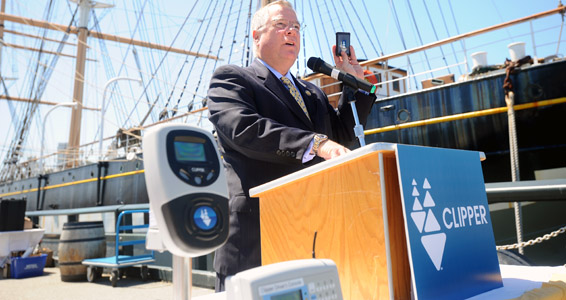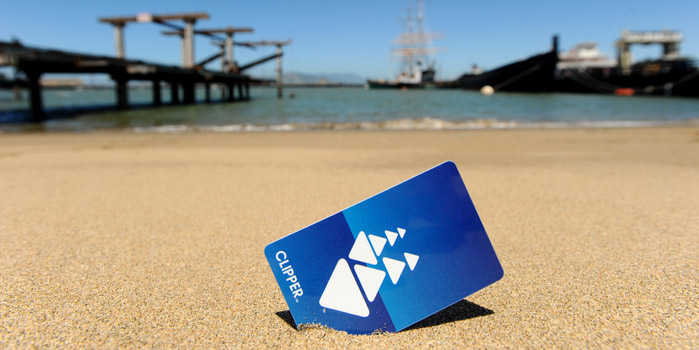“It took eight years, but this little card has turned into an overnight success!” declared Alameda County Supervisor and Metropolitan Transportation Commission Chairman Scott Haggerty at the mid-June ceremony to rechristen the Bay Area’s all-in-one, reloadable transit fare card as ClipperSM, replacing the TransLink® moniker in use since 2002.

Metropolitan Transportation Commission Chair and Alameda County Supervisor Scott Haggerty shows off his brand new Clipper card and an electronic card reader at the launch ceremony for the Bay Area’s regional transit-fare payment card. Photo by Noah Berger
Bay Area Transit Riders Set Sail With Clipper
By John Goodwin
Published: July, 2010
“It took eight years, but this little card has turned into an overnight success!” declared Alameda County Supervisor and Metropolitan Transportation Commission Chairman Scott Haggerty at the mid-June ceremony to rechristen the Bay Area’s all-in-one, reloadable transit fare card as ClipperSM, replacing the TransLink® moniker in use since 2002.
Clipper is now available for fare payment on all routes and at all stations operated by AC Transit, BART, Caltrain, Dumbarton Express, Golden Gate Transit & Ferry and San Francisco Muni. There are more than 100,000 active Clipper cards in circulation and daily boardings are up from about 25,000 last June to about 63,000 a day now. “That’s roughly equal to every single passenger on Caltrain and Golden Gate Transit combined using Clipper every day,” explained Haggerty.
Haggerty also used the occasion of the rechristening celebration — held dockside next to the historic square-rigger Balclutha at the San Francisco Maritime National Historical Park — to announce that Clipper cards will be available free of charge for all customers through the rest of this summer. The distinctive blue and white cards ordinarily cost $5, though this cost is waived when customers sign up for Autoload, a feature allowing passengers to add value to their cards automatically from a bank account or credit card.
Riders can order a free Clipper card, add electronic value that is accepted on all transit systems, or add a monthly pass for a specific agency online at www.clippercard.com, by phone (1-877-878-8883) or TDD/TTY (711 or 1-800-735-2929), at select transit agency ticket offices, or at more than 200 participating retail locations — including the Bay Crossings store in San Francisco’s Ferry Building. In addition to the Autoload option, Clipper also offers card replacement and balance restoration for customers who register cards that later end up lost or damaged. Registration is free and can be completed easily online, over the phone or by mail.
Already Shipshape for Most Bay Area Transit Passengers
Transit operators already accepting Clipper for fare payment carry more than 80 percent of all Bay Area transit passengers. SamTrans and the Santa Clara Valley Transportation Authority (VTA) are scheduled to begin accepting Clipper throughout their route and station networks later this year. Evenutally, passengers will be able to use the Clipper card to pay fares on all Bay Area transit systems.
San Francisco Muni, which carries the largest number of passengers in the region, is nearing completion of a year-long project to replace aging fare gates throughout its Muni Metro station network with new gates that will only accept Clipper cards. The roughly $29 million initiative includes the installation of new ticket vending machines, through which customers can purchase new single-use Clipper cards.
“The new fare gates and ticket vending machines will provide a tremendous benefit to our customers,” said Nathaniel P. Ford Sr., executive director and chief executive officer of the San Francisco Municipal Transportation Agency. “The new equipment will provide seamless transfers among transit systems in the Bay Area, and generate increased use of Clipper on the Muni system. No need for exact change. No hassles. Customers simply load fare value or passes directly on the Clipper card — which can be accomplished automatically by taking advantage of the Autoload feature.”
In addition to eliminating the need for exact change, the Clipper card makes it unnecessary for customers to carry paper passes, tickets or ride books. Several Bay Area transit agencies this year will begin phasing out various paper fare media and will transition customers to the Clipper card. To use Clipper, passengers simply “tag” their cards by touching them to the Clipper logo on the card reader as they board a bus or enter a transit station. The Clipper system automatically deducts the correct fare and applies any discounts — including transfers — for each trip.
“We chose the Clipper name to evoke the Bay Area’s maritime history and to honor the ‘Clippers’ that have transformed Bay Area transportation through the years,” said Haggerty. “In the 19th century, it was the tremendous speed of the clipper ships that revolutionized travel from the East Coast to San Francisco Bay during the Gold Rush era. In the 1930s, it was the China Clipper that revolutionized air travel with the first commercial service across the Pacific, cutting the travel time from San Francisco to Manila by more than a month. Now it’s the 21st century and this new Clipper card is revolutionizing Bay Area transit.”
John Goodwin is a Public Information Officer for the Metropolitan Transportation Commission and the Bay Area Toll Authority.

The distinctive blue and white Clipper card is now available free of charge. Photo by Noah Berger

